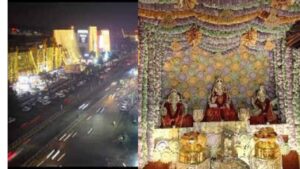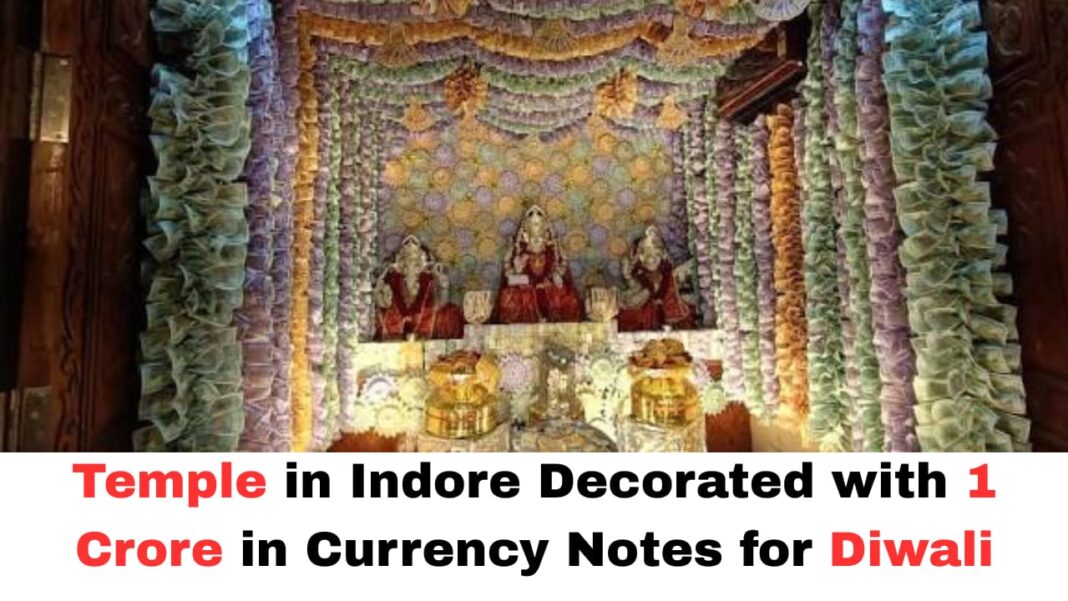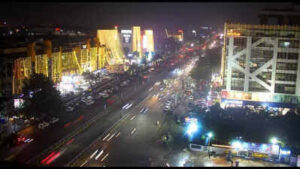Digital News Guru Madhya Pradesh Desk:
Diwali Spectacle: Indore Temple Adorned with Over 1 Crore in Cash
In the city of Indore (Madhya Pradesh), at the Shri Yogmaya Mahalakshmi Temple located in the Moti Bangla area of Shivaji Nagar, a strikingly unconventional devotional effort is taking place for the Diwali festivities. The temple trust, the Shri Yogmaya Mahalakshmi Parmarthik Nyas Samiti, initiated a plan to decorate the temple with currency notes, originally aiming for around 50 lakh ( 5 million).
As word spread and community donations increased, the total crossed the 1.03 crore (~10.3 million) mark. The decorations include myriad denominations of currency notes draped, displayed and affixed around the temple premises and on ritual offerings. The ritual-events kicked off with a Kumkum Archana (special offering with vermilion) to Goddess Mahalakshmi, and on October 19 there was a special offering of 21,000 lotus flowers.

The display is open to devotees during the celebrations, which run till October 22, after which the temple will distribute “Kuber Potli” (symbolic pouches of blessings/offerings) and prasadam (holy food offerings) to participants.
The significance & symbolism
This event taps into multiple layers of cultural, religious and socio-psychological meaning:
- Wealth & prosperity symbolism: The festival of Diwali (and preceding Dhanteras) is traditionally associated with the goddess of wealth, Lakshmi, and becoming prosperous. Using real currency notes as decoration amplifies that theme of material prosperity and divine blessing.
- Collective faith and community participation: What started as a temple’s plan turned into a large-scale communal effort, reflecting how faith rituals often mobilise communities. The trust described the event as a “historic expression of collective faith” turned into a symbol of both spiritual and communal prosperity.
- Visual and experiential impact: The sight of a temple covered in real currency notes is a powerful visual. For devotees and visitors, it creates an immersive experience — merging the everyday medium of money with the sacred space of temple worship.
- Local identity and pilgrimage draw: For Indore and the surrounding region, such a spectacle stands out and may attract even more devotees, media attention, and possibly economic activity (through tourism, local vendors, etc.).
Practicalities and considerations
While the goal is evidently devotional and celebratory, the event also raises practical matters:
- Security & logistics: With over Rs 1 crore in real cash being displayed, there are issues of safeguarding, insurance, handling of contributions, and ensuring that the offerings are not misused or lost.
- Transparency & follow-up: Observers may ask: What happens after the display period? Are the notes returned, used for temple maintenance, charity, or other purposes? The article notes the tradition of returning donations (in similar events elsewhere) but doesn’t detail exactly how this specific temple will handle it.
- Socio-economic optics: In a country with wide economic disparity, the display of an enormous sum of cash for decoration may prompt reflection: some may see it as a joyful expression of devotion and communal giving; others may question whether more could have been done for charitable uses.
- Regulatory/financial implications: Using large sums in cash may intersect with banking regulations, temple trust auditing norms, and tax or donation laws. Though the article doesn’t delve into this, these are underlying issues with large-cash religious donations.
- Authenticity vs. display: While the decoration is symbolic, the underlying belief is that such an offering brings blessings. The temple trust’s framing emphasises the ritual and spiritual significance rather than mere display, but public perception may differ.

Context & precedents
This isn’t entirely without precedent. Other temples and festivals have also used large sums of currency (or even gold/silver) as part of decoration or offering rituals. For instance:
- A temple in Telangana decorated with over 1 crore in origami currency flowers during Dussehra.
- Another temple in Visakhapatnam adorned its deity with 7 kg of gold + 12 kg of silver + currency worth 5 crore during Sharannavaratri.
This shows that such acts are part of a continuum: temples using decorated wealth (in various forms) to reflect devotion, celebrate festivals, and draw the faithful.
Implications & reflections
What might the broader implications be?
- Ritual innovation: This decoration is a kind of contemporary ritual innovation — the medium (paper currency) is modern, the scale large, the spectacle notable — yet it is rooted in age-old themes of offering and devotion.
- Faith economy: The event is an example of how faith and economy intertwine. Money here serves dual roles: a material good and a ritual medium. The act of donating and displaying money becomes an offering of both financial and symbolic value.
- Community engagement: The fact that the target was doubled (from 50 lakh to over 1 crore) reflects strong community response. That level of engagement may boost the temple’s prominence and solidarity of the local community.
- Festival tourism: With media mentions, unusual decorations like this can attract visitors and devotees from outside the immediate region, potentially benefiting local vendors, hospitality and transport services.
- Questions for future: Will this set a precedent for more grand “currency‐note decorations”? Will other temples feel pressure to match or compete, or will norms evolve about how much money is shown in such displays? Also, will there be greater scrutiny about how such donations are managed and used after the festival?
Conclusion
The spectacle at the Shri Yogmaya Mahalakshmi Temple in Indore — a real-cash, high-value decoration of over 1 crore in currency notes for Diwali — is a fascinating blend of devotion, display, community participation and ritual innovation. What might look on the surface like a flamboyant act is also rich in cultural meaning: it reflects deep-rooted beliefs about prosperity, offerings to the divine, and communal expressions of faith.
At the same time, it brings into focus modern questions about transparency, symbolism vs substance, and how religious communities negotiate the use of money in public worship. The drama of currency notes draped across a temple is more than just visual—it invites reflection about what devotion, giving and sacred space mean in contemporary India.
As the festival period concludes and the “Kuber Potli” and prasadam are distributed, it will be worth watching how the temple trust handles the aftermath: the logistics of returning or utilising the funds, the visitor reactions, the media attention, and whether this event becomes a model (or caution) for similar temple initiatives in the future.
You May Also Read: Green Crackers Go on Sale in Delhi: What the October 18-20 Window Means









